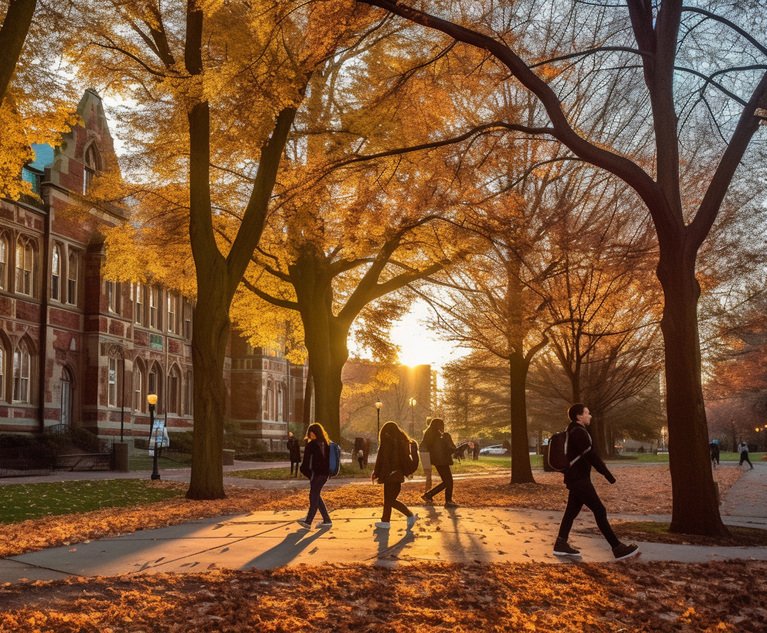 Judith Gundersen. Courtesy photo
Judith Gundersen. Courtesy photoFebruary Multistate Bar Exam Scores Inch Up After a Five-Year Slide
Despite the national average MBE score increasing 1.2 points, early results from individual jurisdictions are mixed.
April 16, 2019 at 01:18 PM
4 minute read
Things may finally be looking up for February bar takers.
The national average score on the Multistate Bar Exam—the multiple-choice portion of the test—increased by 1.2 points to 134 for the February 2019 test, according to the National Conference of Bar Examiners. That represents the first increase in the mean February MBE score since 2013, which was followed by a five-year slide in bar exam pass rates. (Read more about that decline in the first installment of “The Big Fail,” a four-part series on falling bar pass rates and their impact on the legal industry.)
“This is good news,” said national conference president Judith Gundersen in an interview Tuesday. “It should translate into higher pass rates because the MBE is half the exam. We would expect that in jurisdictions that do have a better MBE score, their pass rates will go up. Now, not every jurisdiction had an increase in their MBE mean.”
Early results from the February exam are mixed. The Pennsylvania Board of Bar Examiners announced last week that 60 percent of the 510 people who took the February exam passed. That's up from 53 percent the previous year. Virginia's February pass rate went from 50 percent in 2018 to 63 percent this year.
However, the overall pass rate slipped slightly in Florida, where 57.3 percent of takers passed. The pass rate was 57.9 percent in 2018. Illinois also posted a lower pass rate at 52 percent—three percentage points lower than in 2018. Most jurisdictions have not yet released their February results. New York is expected to release them later this month, while California generally announces pass rates midway through May.
Significantly fewer people take the bar exam in February than in July, which is the more closely watched of the two test administrations. This year, 21,316 people took the February exam, compared with 45,274 in July of 2018. The February exam also has a higher percentage of repeat bar takers, so pass rates tend to be lower. (The average MBE score last July was 139.5—more than five points higher than the most recent February average.)
According to the new data from the national conference, the percentage of people taking the bar for the first time in February continued to drop this year. They accounted for just 22 percent of recent test takers. Similarly, the percentage of people taking the bar again after already passing in another jurisdiction continued to fall, landing at 6 percent. The national conference did not have data for 10 percent of February test takers, as to whether they were first-time or repeat takers.
Since first-time test takers and takers who have already passed the exam in another jurisdiction generally pass at a higher rate than those repeating the exam after failing, the higher average MBE score for February is somewhat unexpected. Repeat test takers saw a larger increase in their average MBE score than did first-time takers, the national conference noted.
“That surprised us a little,” Gundersen said. “It's great that the repeaters improved so much. What does that mean? I don't know. Did people study differently, or did they put more time into it? Our researchers are looking at it. Part of it—for us—is that there is a lot we don't know. We don't know what people did to prepare for the exam. We don't know about their curriculum choices.”
It's uncertain whether the increase in the February average MBE marks the start of a sustained recovery in pass rates. Many legal educators hoped that a higher average MBE on the July 2016 and 2017 bar exams meant that pass rates were recovering, but the average MBE sank to a historic low the following year.
Derek Muller, a professor at Pepperdine University School of Law who tracks bar exam trends on his Excess of Democracy blog, said that the uptick in February's average MBE score could correlate to the large number of people who failed the bar in July if there were many people who just barely missed the cut then.
“It might simply have been some bad luck from test-takers [in July], and there were more near-fails than previous years,” he said. “So that cohort looked stronger this February 2019.”
This content has been archived. It is available through our partners, LexisNexis® and Bloomberg Law.
To view this content, please continue to their sites.
Not a Lexis Subscriber?
Subscribe Now
Not a Bloomberg Law Subscriber?
Subscribe Now
NOT FOR REPRINT
© 2024 ALM Global, LLC, All Rights Reserved. Request academic re-use from www.copyright.com. All other uses, submit a request to [email protected]. For more information visit Asset & Logo Licensing.
You Might Like
View All
From 'Confusing Labyrinth' to Speeding 'Roller Coaster': Uncertainty Reigns in Title IX as Litigators Await Second Trump Admin
6 minute read
Federal Judge Weighs In on School's Discipline for 'Explicitly Copying AI-Generated Text' on Project

Trump’s DOE Pick Could Spell Trouble for Title IX Enforcement, Higher Ed Funding
4 minute read
'What Is Certain Is Uncertainty': Patchwork Title IX Rules Face Expected Changes in Second Trump Administration
5 minute readTrending Stories
Who Got The Work
Michael G. Bongiorno, Andrew Scott Dulberg and Elizabeth E. Driscoll from Wilmer Cutler Pickering Hale and Dorr have stepped in to represent Symbotic Inc., an A.I.-enabled technology platform that focuses on increasing supply chain efficiency, and other defendants in a pending shareholder derivative lawsuit. The case, filed Oct. 2 in Massachusetts District Court by the Brown Law Firm on behalf of Stephen Austen, accuses certain officers and directors of misleading investors in regard to Symbotic's potential for margin growth by failing to disclose that the company was not equipped to timely deploy its systems or manage expenses through project delays. The case, assigned to U.S. District Judge Nathaniel M. Gorton, is 1:24-cv-12522, Austen v. Cohen et al.
Who Got The Work
Edmund Polubinski and Marie Killmond of Davis Polk & Wardwell have entered appearances for data platform software development company MongoDB and other defendants in a pending shareholder derivative lawsuit. The action, filed Oct. 7 in New York Southern District Court by the Brown Law Firm, accuses the company's directors and/or officers of falsely expressing confidence in the company’s restructuring of its sales incentive plan and downplaying the severity of decreases in its upfront commitments. The case is 1:24-cv-07594, Roy v. Ittycheria et al.
Who Got The Work
Amy O. Bruchs and Kurt F. Ellison of Michael Best & Friedrich have entered appearances for Epic Systems Corp. in a pending employment discrimination lawsuit. The suit was filed Sept. 7 in Wisconsin Western District Court by Levine Eisberner LLC and Siri & Glimstad on behalf of a project manager who claims that he was wrongfully terminated after applying for a religious exemption to the defendant's COVID-19 vaccine mandate. The case, assigned to U.S. Magistrate Judge Anita Marie Boor, is 3:24-cv-00630, Secker, Nathan v. Epic Systems Corporation.
Who Got The Work
David X. Sullivan, Thomas J. Finn and Gregory A. Hall from McCarter & English have entered appearances for Sunrun Installation Services in a pending civil rights lawsuit. The complaint was filed Sept. 4 in Connecticut District Court by attorney Robert M. Berke on behalf of former employee George Edward Steins, who was arrested and charged with employing an unregistered home improvement salesperson. The complaint alleges that had Sunrun informed the Connecticut Department of Consumer Protection that the plaintiff's employment had ended in 2017 and that he no longer held Sunrun's home improvement contractor license, he would not have been hit with charges, which were dismissed in May 2024. The case, assigned to U.S. District Judge Jeffrey A. Meyer, is 3:24-cv-01423, Steins v. Sunrun, Inc. et al.
Who Got The Work
Greenberg Traurig shareholder Joshua L. Raskin has entered an appearance for boohoo.com UK Ltd. in a pending patent infringement lawsuit. The suit, filed Sept. 3 in Texas Eastern District Court by Rozier Hardt McDonough on behalf of Alto Dynamics, asserts five patents related to an online shopping platform. The case, assigned to U.S. District Judge Rodney Gilstrap, is 2:24-cv-00719, Alto Dynamics, LLC v. boohoo.com UK Limited.
Featured Firms
Law Offices of Gary Martin Hays & Associates, P.C.
(470) 294-1674
Law Offices of Mark E. Salomone
(857) 444-6468
Smith & Hassler
(713) 739-1250








